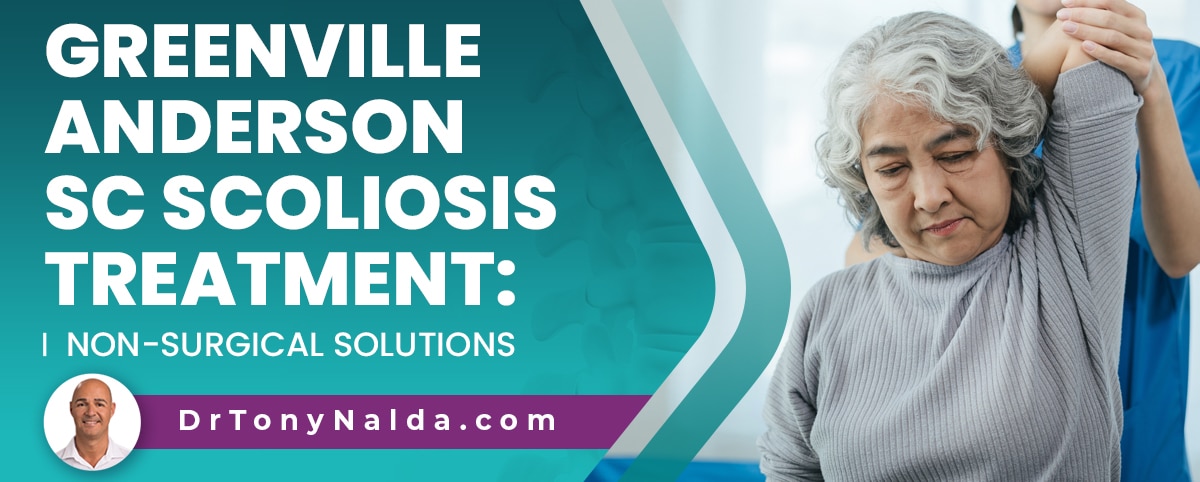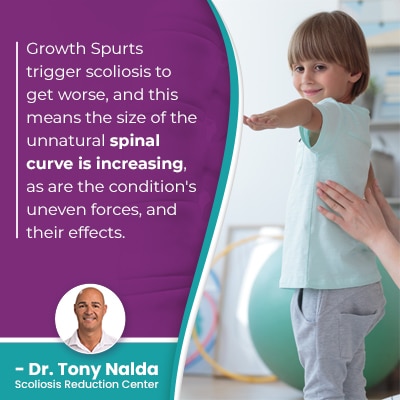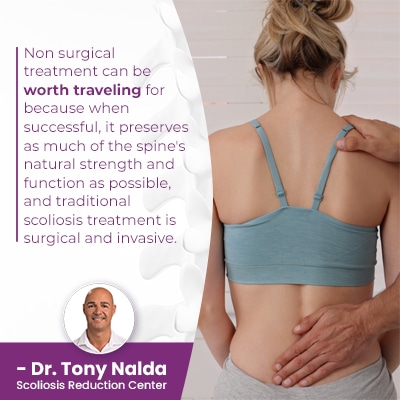Greenville Anderson SC Scoliosis Treatment: Non-Surgical Solutions

Scoliosis is a structural spinal condition, but it can cause widespread effects felt throughout the body. One of the main differences in how children versus adults experience scoliosis is pain; continue reading to find out more.
A 2-hour flight can make Dr. Tony Nalda's Scoliosis Reduction Center® accessible to Greenville Anderson residents. The best way to minimize the potential effects of scoliosis is to treat it proactively, and conservative non-surgical treatment options have proven results.
As condition effects can be minimized with successful treatment, let's explore the main scoliosis symptoms.
Table of Contents
Scoliosis in Children
Scoliosis is most often diagnosed in children and is the most common spinal condition to affect school-aged children, but it can affect all ages.
Scoliosis causes an unnatural spinal curve that rotates to develop, and the condition is progressive, meaning its nature is to get worse over time.
Most cases of childhood scoliosis are idiopathic (cause unknown), but neuromuscular scoliosis and congenital scoliosis affect children and are associated with known causes.
Neuromuscular scoliosis is caused by the presence of a larger neuromuscular condition like spina bifida, cerebral palsy, and muscular dystrophy, and congenital scoliosis is caused by a malformed spine that develops in utero.
Idiopathic scoliosis is thought to be multifactorial: caused by a number of factors, or a combination of factors, that can vary from person to person.
Babies born with scoliosis are diagnosed with congenital scoliosis; infantile scoliosis affects infants between the ages of 6 months and 3 years old; early-onset juvenile scoliosis is diagnosed in children between the ages of 3 and 10, and the condition's most common type overall is adolescent idiopathic scoliosis, diagnosed between 10 years old and reaching skeletal maturity.
While most cases of childhood scoliosis are idiopathic, we know it's growth that triggers progression.
Growth and Progression
 Growth Spurts trigger scoliosis to get worse, and this means the size of the unnatural spinal curve is increasing, as are the condition's uneven forces, and their effects.
Growth Spurts trigger scoliosis to get worse, and this means the size of the unnatural spinal curve is increasing, as are the condition's uneven forces, and their effects.
As growth triggers progression, children have the most potential progression to face.
Adolescents are the most at risk for rapid phase progression because of the rapid and unpredictable growth spurts of puberty.
As scoliosis progresses, it's becoming more complex to treat; larger curves are harder to correct, and progression makes the spine increasingly rigid and less responsive to treatment.
In addition, increasing spinal rigidity can also disrupt a patient's ability to perform key therapeutic exercises as part of treatment.
As progression occurs, condition effects become more pronounced, and in childhood scoliosis, the main effects involve postural changes:
- Uneven eyeline
- Uneven shoulders
- Uneven shoulder blades
- The development of a rib cage arch
- Uneven hips
- Arms and legs that appear to hang at different lengths
The postural changes of childhood scoliosis are caused by the condition's uneven forces disrupting the body's overall symmetry.
A main difference in childhood versus adult scoliosis is pain, and this is because scoliosis doesn't become a compressive condition until skeletal maturity has been reached.
Pain in Adult Scoliosis
Once skeletal maturity has been reached, scoliosis tends to become painful, and this can involve muscle spasms, weakened muscles, and muscle pain, back pain, and pain that radiates into the extremities due to nerve compression.
In young patients who are still growing, the constant lengthening motion of growth counteracts the compressive force of the unnatural spinal curve, but once growth has stopped, pain is the main symptom of adult scoliosis.
It's most often pain in the hands and feet that bring adults in to see me for assessment and diagnosis, and the two main condition types to affect adults are idiopathic scoliosis and degenerative scoliosis.
Cases of idiopathic scoliosis in adults involve adolescents who were neither diagnosed nor treated.
Changes to Movement
As scoliosis progresses, the spine is becoming increasingly unbalanced and unstable, and this shifts the body's center of gravity and can affect movement in a number of ways.
Scoliosis is known to disrupt proprioception (the body's ability to orient itself without visual cues), balance, coordination, and gait.
Adults experience postural changes that include a prominent lean to one side, and patients of all ages can experience changes to movement, particularly gait, and tiredness can develop as it takes more energy to try and counteract an uneconomical gait and the condition's uneven forces.
As the spine works in tandem with the brain to form the body's central nervous system (CNS), an unnatural spinal curve can affect the body in a number of ways, including disrupting brain-body communication.
Postural changes will increase alongside progression, and in most cases, it's the area of the body located the closest to an affected spinal section that will feel the majority of the condition's direct effects.
The more progression that occurs, the more overt and established condition effects become, and the more difficult they are to improve/reverse, hence the benefit of a proactive treatment approach.
Non Surgical Treatment Options
 A 2-hour flight to Orlando, Florida's Scoliosis Reduction Center® can be worth it for Greenville, Anderson residents if it means accessing non surgical treatment options with proven results.
A 2-hour flight to Orlando, Florida's Scoliosis Reduction Center® can be worth it for Greenville, Anderson residents if it means accessing non surgical treatment options with proven results.
While I can never guarantee treatment results, early detection and intervention are valued in non-surgical treatment, and this means diagnosing conditions early in their progressive lines and responding to a diagnosis with immediate treatment.
The milder scoliosis is, the simpler it is to treat, and the more likely it is that it will respond well, so the sooner treatment is started, the better, and as a progressive condition is virtually guaranteed to get worse at some point, simply watching and waiting for progression is wasting valuable treatment time.
Conservative treatment is what patients of the Center benefit from, and treatment plans are customized and integrative: combining the power of multiple scoliosis-specific treatment disciplines so conditions can be impacted on every level.
Non surgical treatment includes chiropractic care, physical therapy, scoliosis exercises, corrective bracing, and rehabilitation.
Non surgical treatment can be worth traveling for because when successful, it preserves as much of the spine's natural strength and function as possible, and traditional scoliosis treatment is surgical and invasive.
Scoliosis Surgery Risks
While spinal surgeons have their patients' best interests at heart, spinal surgery is invasive and risky, and scoliosis surgery is no exception.
Spinal fusion surgery involves fusing the curve's most-tilted vertebrae at the curve's apex into one solid bone, and metal rods are commonly attached to the spine to hold it in place.
A spine that's fused is fused for life, and if a fusion is unsuccessful for any reason, the only recourse is more surgery, and the risks of spinal fusion surgery and revision surgery only increase with age.
Excessive blood loss, infection, and nerve damage are risks of the procedure, and the long-term risks involve the long-term effects on spinal health and function.
A spine that's fused is one that's less moveable, and a noticeable loss in spinal flexibility and range of motion is one of the most noted effects, as is an increase in back pain and a spine that's weaker and more vulnerable to injury.
While there is still a place for spinal fusion in the treatment of severe cases and/or atypical cases of scoliosis, the reality is that particularly with early detection and intervention, many cases of scoliosis don't require surgical treatment.
Conclusion
Those looking for Greenville Anderson scoliosis treatment, a 2-hour flight can mean accessing the innovative and integrative approach of renowned scoliosis chiropractor, Dr. Tony Nalda of the Scoliosis Reduction Center®.
Treatments for scoliosis have to be proactive, and the best time to start treatment for progressive conditions like scoliosis is always now.
There are never treatment guarantees, but the Center's results speak for themselves, and with early detection and intervention, there are fewer limits to what non surgical scoliosis treatment can achieve.
The focus of non surgical treatment is on addressing the condition's underlying structural nature by working towards a curvature reduction through chiropractic care.
Physical therapy and scoliosis exercises can work towards increasing the strength and balance of the spine's surrounding muscles for better spinal support and stability.
Corrective bracing is particularly effective on growing spines so is a regular facet of childhood scoliosis non surgical treatment, and rehabilitation is about holding treatment results, and this can involve continued chiropractic care, lifestyle guidance, and custom prescribed home exercises to further heal and stabilize the spine
The complexity of scoliosis necessitates the combination of multiple powerful treatment disciplines so conditions can be impacted on every level; it's not just the spine that's affected by scoliosis, but also its surroundings, and the entire body.
If you are looking for Greenville Anderson scoliosis treatment, don't hesitate to reach out and schedule a consultation.
Dr. Tony Nalda
DOCTOR OF CHIROPRACTIC
After receiving an undergraduate degree in psychology and his Doctorate of Chiropractic from Life University, Dr. Nalda settled in Celebration, Florida and proceeded to build one of Central Florida’s most successful chiropractic clinics.
His experience with patients suffering from scoliosis, and the confusion and frustration they faced, led him to seek a specialty in scoliosis care. In 2006 he completed his Intensive Care Certification from CLEAR Institute, a leading scoliosis educational and certification center.
About Dr. Tony Nalda
 Ready to explore scoliosis treatment? Contact Us Now
Ready to explore scoliosis treatment? Contact Us Now





